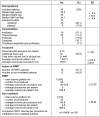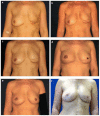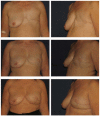Breast reconstruction de novo by water-jet assisted autologous fat grafting--a retrospective study
- PMID: 24403878
- PMCID: PMC3884560
- DOI: 10.3205/000185
Breast reconstruction de novo by water-jet assisted autologous fat grafting--a retrospective study
Abstract
Background: Autologous fat grafting has become a frequent, simple, reproducible and low-risk technique for revisional or partial breast reconstruction. The presented European multicenter study describes an optimized treatment and follow-up protocol for the de novo breast reconstruction after total mastectomy by lipotransfer alone.
Methods: A retrospective European multicenter trial included 135 procedures on 28 (35 breasts) postmastectomy patients (mean 52.4 years). All women were treated with the water-jet assisted fat grafting method (BEAULI™) combined with additional procedures (NAC reconstruction, contralateral mastoplasty) and evaluated with at least 6 months follow-up (mean 2.6 years). Sonography or mammography, clinical examination, patient questionnaire (10-point Likert scale) and digital photographs were carried out.
Results: On average the patients received 4 to 6 procedures each with a single volume of 159 ml (±61 ml) over 21 months (range 9 months to 2.5 years). In total 1,020 ml (±515 ml) fat were grafted till a complete breast reconstruction was achieved. Irradiated patients needed a significantly higher volume than non-irradiated (p<0.041). Main treatment complications were liponecrosis (2.59%), infection (0.74%) and granuloma (0.74%). Patient satisfaction was overall high to very high (96%) and confirmed the good aesthetic results (68%) and the natural softness, contour and shape of the reconstructed breast.
Conclusions: A complete breast reconstruction with large volume fat grafting is alternatively possible to standard techniques in selected cases. It takes at least 4 to 6 lipotransfers in the course of 2 years. Patients with prior radiotherapy may require even up to 8 sessions over nearly 3 years of treatment.
Hintergrund: Heutzutage wird der autologe Eigenfettgewebetransfer in der rekonstruktiven Brustchirurgie als eine risikoarme und einfach anwendbare Methode angesehen und derweilen routiniert für Zweiteingriffe oder Teilaufbauten verwendet. Bisher sind nur wenige Patientenfälle mit einem kompletten Brustaufbau nach totaler Mastektomie beschrieben worden. Material und Methoden: Im Rahmen einer europaweiten Multicenterstudie erhielten insgesamt 28 Patientinnen einen kompletten Brustaufbau nach uni- oder bilateraler Ablatio mammae. Jener wurde ausschließlich mittels Wasserstrahl-assistierter BEAULI™-Methode vollzogen, wobei man diese individuell mit gängigen Verfahren wie einer MAK-Rekonstruktion oder einer kontralateralen Reduktionsplastik kombinierte. Zur Auswertung fand die klinische und radiologische Nachuntersuchung (Ultraschall oder Mammographie) nach abgeschlossener Behandlung und mindestens 6 Monaten (durchschnittlich 2,6 Jahren) Verlaufszeit statt. Zusätzlich wurde anhand digitaler Fotoaufnahmen und Fragebögen (10-Punkte-Likert-Skala) das ästhetische Endergebnis bewertet und die Patientenzufriedenheit ermittelt.Ergebnis: Im Durchschnitt wurden 4 bis 6 Einzelsitzungen mit jeweils 159 ml (±61 ml) über einen Zeitraum von 21 Monaten (9 Monate bis max. 2,5 Jahre) durchgeführt, um durch ein Endvolumen von 1.020 ml (±515 ml) einen kompletten Brustaufbau zu erreichen. Hierbei wiesen Patientinnen nach adjuvanter Radiatio eine signifikant höhere Eingriffsrate und Volumenbedarf auf (p<0,041). Als postoperative Komplikationen traten Infektionen (0,74%), Granulome (0,74%) oder Fettnekrose (2,59%) auf. Es konnte eine hohe Patientenzufriedenheit (95,42%) mit guten bis sehr gutem ästhetischem Ergebnis (67,68%) festgestellt werden. Schlussfolgerungen: Der autologe Eigenfettgewebetransfer kann zu einem kompletten Brustaufbau nach Ablatio mammae in ausgewählten Fällen eingesetzt werden, wobei durchschnittlich 4 bis 6 Lipotransfers in einem Zeitraum von ca. 2 Jahren vorgesehen sind. Nach adjuvanter Radiotherapie können bis zu 8 Sitzungen im Verlauf von bis zu 3 Jahren notwendig sein. Die vorliegenden Ergebnisse führten in den entsprechenden Schwerpunktzentren zur Entwicklung optimierter Behandlungsstandards von Brustkrebspatientinnen.
Keywords: autologous fat grafting; breast reconstruction; lipotransfer; mastectomy.
Figures








Similar articles
-
Autologous Fat Grafting After Breast Reconstruction in Postmastectomy Patients: Complications, Biopsy Rates, and Locoregional Cancer Recurrence Rates.Ann Plast Surg. 2016 Mar;76(3):270-5. doi: 10.1097/SAP.0000000000000561. Ann Plast Surg. 2016. PMID: 26101979
-
The role of autologous fat grafting in secondary microsurgical breast reconstruction.Ann Plast Surg. 2013 Jul;71(1):24-30. doi: 10.1097/SAP.0b013e3182920ad0. Ann Plast Surg. 2013. PMID: 23788122
-
The Influence of Fat Grafting on Breast Imaging after Postmastectomy Reconstruction: A Matched Cohort Analysis.Plast Reconstr Surg. 2020 Dec;146(6):1227-1236. doi: 10.1097/PRS.0000000000007327. Plast Reconstr Surg. 2020. PMID: 33234948
-
[APPLICATION AND RESEARCH PROGRESS OF AUTOLOGOUS FAT GRAFTING IN BREAST RECONSTRUCTION].Zhongguo Xiu Fu Chong Jian Wai Ke Za Zhi. 2016 Jan;30(1):123-8. Zhongguo Xiu Fu Chong Jian Wai Ke Za Zhi. 2016. PMID: 27062860 Review. Chinese.
-
Radiographic Implications of Fat Grafting to the Reconstructed Breast.Breast J. 2015 Sep-Oct;21(5):520-5. doi: 10.1111/tbj.12450. Epub 2015 Jul 1. Breast J. 2015. PMID: 26133468 Review.
Cited by
-
The Collection of Adipose Derived Stem Cells using Water-Jet Assisted Lipoplasty for their Use in Plastic and Reconstructive Surgery: A Preliminary Study.Front Cell Dev Biol. 2016 Nov 22;4:136. doi: 10.3389/fcell.2016.00136. eCollection 2016. Front Cell Dev Biol. 2016. PMID: 27921032 Free PMC article.
-
Full breast reconstruction with fat and how to recycle the "dog-ear".Gland Surg. 2019 Oct;8(Suppl 4):S297-S300. doi: 10.21037/gs.2019.05.07. Gland Surg. 2019. PMID: 31709171 Free PMC article.
-
International Expert Panel Consensus on Fat Grafting of the Breast.Plast Reconstr Surg Glob Open. 2019 Oct 28;7(10):e2426. doi: 10.1097/GOX.0000000000002426. eCollection 2019 Oct. Plast Reconstr Surg Glob Open. 2019. PMID: 31772879 Free PMC article.
-
Comparative Analysis of Two Automated Fat-processing Systems.Plast Reconstr Surg Glob Open. 2020 Jan 17;8(1):e2587. doi: 10.1097/GOX.0000000000002587. eCollection 2020 Jan. Plast Reconstr Surg Glob Open. 2020. PMID: 32095398 Free PMC article.
-
Research trends and performances of breast reconstruction: a bibliometric analysis.Ann Transl Med. 2020 Nov;8(22):1529. doi: 10.21037/atm-20-3476. Ann Transl Med. 2020. PMID: 33313274 Free PMC article.
References
-
- American Cancer Society. Breast Cancer Facts & Figures 2011–2012. Atlanta: American Cancer Society Inc; 2012. Available from: http://www.cancer.org/acs/groups/content/@epidemiologysurveilance/docume....
-
- Autio P, Saarto T, Tenhunen M, Elomaa I, Risteli J, Lahtinen T. Demonstration of increased collagen synthesis in irradiated human skin in vivo. Br J Cancer. 1998 Jun;77(12):2331–2335. doi: 10.1038/bjc.1998.387. Available from: http://dx.doi.org/10.1038/bjc.1998.387. - DOI - DOI - PMC - PubMed
-
- Babovic S. Complete breast reconstruction with autologous fat graft – a case report. J Plast Reconstr Aesthet Surg. 2010 Jul;63(7):e561–e563. doi: 10.1016/j.bjps.2009.11.027. Available from: http://dx.doi.org/10.1016/j.bjps.2009.11.027. - DOI - DOI - PubMed
-
- Bernstein EF, Sullivan FJ, Mitchell JB, Salomon GD, Glatstein E. Biology of chronic radiation effect on tissues and wound healing. Clin Plast Surg. 1993 Jul;20(3):435–453. - PubMed
-
- Bertolini F, Lohsiriwat V, Petit JY, Kolonin MG. Adipose tissue cells, lipotransfer and cancer: a challenge for scientists, oncologists and surgeons. Biochim Biophys Acta. 2012 Aug;1826(1):209–214. doi: 10.1016/j.bbcan.2012.04.004. Available from: http://dx.doi.org/10.1016/j.bbcan.2012.04.004. - DOI - DOI - PubMed
Publication types
MeSH terms
LinkOut - more resources
Full Text Sources
Medical

